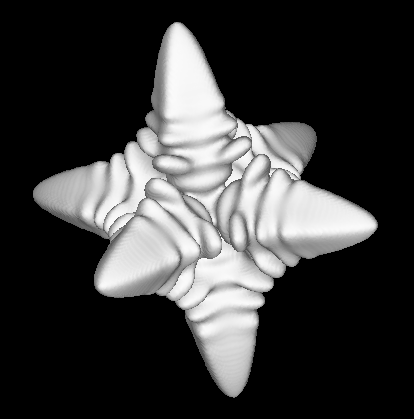

Dendritic growth: in greek, the word "dendron" means tree. Dendrites are branched, tree-like structures. The most widely known example is the ordinary snowflake; however, similar processes as in snowflake formation occur during the processing of metallic alloys. Therefore, considerable interest in such phenomena comes from materials science. The aim is to know the forms and sizes of the growing structures as functions of the control parameters. The image you see here has been obtained by the simulation of a phase-field model for the solidification of a pure substance and shows the crystal that develops from an initial solid germ under the action of anisotropic surface tension with a cubic symmetry.
Eutectic colonies: These complicated finger-like structures consisting of fine lamellae of two different solids (blue and red) arise during the directional solidification of eutectic alloys. Eutectic alloys are widely used in the metallurgical industry. For example, the standard solder mixture Sn-Pb is a eutectic. The word "eutectic" is of greek origin and means that the alloy melts easily. The eutectic composition is the alloy composition at which the melting temperature is lowest. At this point, liquid can coexist with two different solid phases of different compositions. If such a material is forced to solidify, for example by pulling it from a hot towards a cold zone (zone refining or directional solidification), it will spontaneously form fine rods or lamellae as the two solid phases "cooperate" to grow faster. If a supplementary ternary impurity is present, this eutectic front may become unstable, and large superstructures, called colonies or two-phase cells, emerge spontaneously. The colonies shown above are obtained by computer simulations using the phase-field method. The cells grow upward, the sample is pulled downward, and the cells are solid while the top is liquid. The concentration of ternary impurities is proportional to the intensity of green, and the composition of the solid is shown on the color axis from red to blue. The light blue and yellow auras in front of the solid are a visualization of the diffusion field in the liquid.
Spiral surface growth: many crystals are facetted, which means that their surfaces are composed of flat terraces of tightly packed atoms, separated by steps with a height of one atomic unit cell. Such crystals grow mainly by incorporation of new atoms at the steps. When crystals grow from vapor, or are grown by epitaxy, the incorporation occurs in two steps: atoms are first adsorbed onto the terraces and diffuse to a step, or they can desorb again into the vapor. The step advances when new atoms are incorporated. But the step may be pinned at the center of screw dislocations and winds into a spiral. The complex interplay between the shape of the spiral, the diffusion of adatoms and the advance of the steps is simulated using a newly developed phase-field method. The pictures show some snapshots of a step about to wind itself into a spiral around a dislocation and are taken after 5, 20, and 50 turns of the spiral center. The step is shown as black line; the density of adsorbed atoms on the surface is shown in orange.
Spinodal decomposition: this process, also termed phase separation, takes place for example when one quenches a mixture of two substances rapidly below the demixing temperature. Then, the two substances separate locally, giving rise to the complicated structures which can be seen on the leftmost picture. The subsequent pictures are taken at later times. As in real life, the big ones eat the small: the whole structure coarsens by diffusion of material from structures with strongly curved features to those which are flatter. The characteristic length scale of such systems usually grows for late time as a power law. The pictures are taken from simulations of a mean-field kinetic equation based on a lattice-gas model.